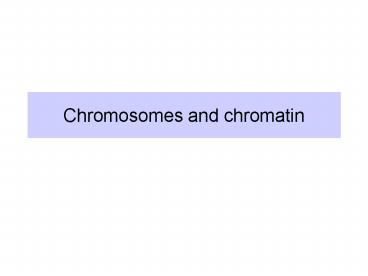Chromosomes and chromatin - PowerPoint PPT Presentation
1 / 24
Title:
Chromosomes and chromatin
Description:
Chromosomes and chromatin. Chromosomes organize and package genes ... Human chromosomes, spectral karyotype. Reagents specific to each chromosome. Chromosome ... – PowerPoint PPT presentation
Number of Views:38
Avg rating:3.0/5.0
Title: Chromosomes and chromatin
1
Chromosomes and chromatin
2
Chromosomes organize and package genes inside
cells
- Bind packaging proteins to DNA to make it more
compact. - Histones DNA chromatin in eukaryotes
- Virion proteins in viruses
- HU (?) or other proteins in bacteria
- Loop chromatin and attach it to a matrix in nuclei
3
Bands and specialized regions of human chromosomes
Human chromosome 11 125 Mb, 180 cM
4
Human chromosomes, ideograms
Mitotic chromosomes are spread and stained with
Geimsa. Those that stain are shown in
black. G-bands (more AT rich).
5
Human chromosomes, spectral karyotype
Reagents specific to each chromosome. Chromosome p
ainting.
6
Identifying translocations
http//www.ncbi.nlm.nih.gov/disease/
7
Distinctive and common features of chromosomes
- Distinctive proteins and DNA sequences have been
used to develop chromosome painting reagents. - Genomic DNA in vertebrates has long (megabase)
stretches of GC rich DNA, and other long
stretches of AT rich DNA - Called isochores
- Virtually all this DNA is organized into
chromatin, which has a common fundamental
structure.
8
Chromatin Structure
9
Principal proteins in chromatin are histones
H3 and H4 Arg rich, mostly conserved
sequence H2A and H2B Slightly Lys rich, fairly
conserved H1 very Lys rich, most variable in
sequence between species
10
Histone structure and function
11
Histone interactions via the histone fold
12
Nucleosomes are the subunits of the chromatin
fiber
- Experimental evidence
- Beads on a string in EM
- Micrococcal nuclease digestion
13
General model for the nucleosomal core
14
A string of nucleosomes
15
Detailed structure of the nucleosomal core
16
Higher order chromatin structure
Histone H1 associates with the linker DNA, and
may play a role in forming higher order
structures.
17
Alterations to chromatin structure are key steps
in regulation
18
Phosphorylation of histones
19
Acetylation and Deacetylation of lysines in
proteins
20
Acetylation and Deacetylation of histones
21
Effects of histone modifications
- Highly acetylated histones are associated with
actively transcribed chromatin - Acetylation of histone N-terminal tails may
affect the ability of nucleosomes to associate in
higher-order structures - The acetylated chromatin appears to be more
open, and accessible to transcription factors
and polymerases - HATs are implicated as co-activators of genes in
chromatin, and HDACs are implicated as
co-repressors
22
Matrix and scaffold
In interphase chromosomes, at least some DNA is
attached to a matrix
Mitotic chromosomes, with some DNA released
23
Chromosome localization in interphase
In interphase, chromosomes appear to be localized
to a sub-region of the nucleus.
24
Gene activation and location in the nucleus
- Condensed chromatin tends to localize close to
the centromeres - Pericentromeric heterochromatin
- Movement of genes during activation and silencing
- High resolution in situ hybridization
- Active genes found away from pericentromeric
heterochromatin - Silenced genes found associated with
pericentromeric heterochromatin

